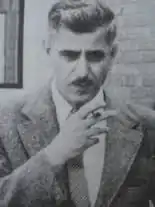Abdul Jabbar Abdullah | |
|---|---|
 Abdul Jabbar Abdullah | |
| Born | 1911 |
| Died | July 9, 1969 (aged 57–58) |
| Nationality | Iraqi |
| Alma mater | Massachusetts Institute of Technology |
| Known for | Cloud stratification |
| Scientific career | |
| Fields | Wave theory, Meteorology |
| Institutions | University of Baghdad Massachusetts Institute of Technology New York University National Center for Atmospheric Research |
Abdul Jabbar Abdullah Sam (Arabic: عبد الجبار عبد الله سام) (1911 – July 9, 1969) was an Iraqi wave theory physicist, dynamical meteorologist, and President Emeritus of the University of Baghdad.[1] Abdullah obtained a doctorate in meteorology at the Massachusetts Institute of Technology in 1946[2][3] before returning to Iraq to become an educator and researcher. After several years as the President of the University of Baghdad, Abdullah left Iraq amid a period of social unrest, and lived in the United States for the remainder of his life.
Biography
Abdul Jabbar was born in 1911 to a Mandaean family in the town of Qal'at Saleh, Qal'at Saleh District, Maysan Province (formerly Al-Amaarah) in southeastern Iraq.[4] He studied in his hometown elementary school, built during the British rule in Iraq. Upon finishing his secondary school education in Baghdad, he left for Lebanon to attend university. There he enrolled at the American University of Beirut (AUB) where he majored in physics and graduated with a BS in 1934. He subsequently pursued his postgraduate studies at the Massachusetts Institute of Technology (MIT), where he earned his PhD, supervised by Bernhard Haurwitz.
In 1949, Abdullah returned to Iraq and joined the faculty of The Higher Normal College, where he served as chairman of the physics department. When the college, along with other Iraqi universities, was consolidated into the University of Baghdad, Abdullah was a member of the Founding Council, which oversaw the unification process. In the aftermath of the 14 July Revolution in 1958, the Founding Council was replaced with a permanent University Council, and Abdullah was named the first president of the University of Baghdad.
Abdullah was imprisoned during the February 1963 coup d'état in Iraq by the revolting Ba'ath forces, who charged him with being a political dissident. He was released from jail in October, although the charges were not dropped until several years later. Owing to mounting international pressure, he was eventually allowed to leave the country, and went to the United States. He took a position as a meteorology researcher at the National Center for Atmospheric Research in Boulder, Colorado.
In 1966, Abdullah joined the faculty of the Atmospheric Science department at the State University of New York at Albany. Shortly thereafter, he became ill with Hodgkin lymphoma. He died at the Albany Medical Center on July 9, 1969.[5]
Personal life
He married Kismet Inaissi al-Fayadh in 1943, with whom he had a daughter and three sons.
Legacy
Abdullah is highly regarded in Iraq, where his 100th birthday was commemorated in the diaspora. A hall in the University of Baghdad is named after him, as well as numerous streets in the city.
Nuclear physicist Khidir Hamza cites Abdullah as a mentor, and credits him with helping Hazma obtain admission into MIT to pursue a master's degree in nuclear engineering after Hamza's initial rejection. Hazma later became part of Iraq's nuclear research program, before defecting to the United States and testifying on the program before the U.S. Senate.[6]
Research
Abdullah's research interests included cloud stratification,[7] solitary waves,[8] and pressure pumps.[9]
Bibliography
Abdullah has published multiple books on atmospheric sciences, and was the editor and publisher of Iraq's sole science journal in the 1950s: "Proceedings of the Iraqi Scientific Society".
Books
- Abdul Jabbar Abdullah, James J. O'Brien, National Center for Atmospheric Research (U.S.). Internal Gravity Waves of Finite Amplitude in a Stratified Incompressible Atmosphere: -- a Quasi-characteristic Method. National Center for Atmospheric Research.
- Abdul Jabbar Abdullah. On the Dynamics of Hurricanes. New York University, 1953.
- Abdul Jabbar Abdullah. Group-velocity of Atmospheric Waves. Massachusetts Institute of Technology, 1946.
References
- ↑ National Center for Atmospheric Research. "Repository" (PDF). Archived from the original (PDF) on 11 December 2013. Retrieved 18 June 2013.
- ↑ MIT. "MIT 1961 centennial program" (PDF). MIT. Archived from the original (PDF) on 5 March 2016. Retrieved 18 June 2013.
- ↑ MIT Museum Collections. "MIT Museum Collections". MIT. Retrieved 18 June 2013.
- ↑ "Birth Certificate" (PDF). Retrieved 12 December 2017.
- ↑ "Dr. Abdul Abdullah, Meteorologist, 57" (PDF). The New York Times. 12 July 1969. Retrieved 12 December 2017.
- ↑ Hamza, Khidhir; Jeff Stein (2001). Bombmaker: The Terrifiying Inside Story of the Iraqi Nuclear and Biological Weapons. Simon and Schuster.
- ↑ Abdullah, Abdul Jabbar (1967). "Stratification of Cloud Layers in a Stable Atmosphere" (PDF). Monthly Weather Review. 95 (4): 189–197. Bibcode:1967MWRv...95..189A. CiteSeerX 10.1.1.395.3634. doi:10.1175/1520-0493(1967)095<0189:soclia>2.3.co;2.
- ↑ Abdullah, Abdul Jabbar (1956). "A Note on the Atmospheric Solitary Wave". Journal of Meteorology. 13 (4): 381–387. Bibcode:1956JAtS...13..381A. doi:10.1175/1520-0469(1956)013<0381:ANOTAS>2.0.CO;2.
- ↑ Abdul Jabbar, Abdullah (1953). "Head-on collision between two pressure jumps". Journal of Geophysical Research. 71 (8): 1953–1962. Bibcode:1966JGR....71.1953J. doi:10.1029/JZ071i008p01953.